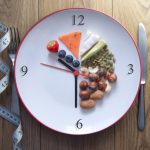(HealthDay News) — Diets that stress calorie restriction versus those that stress fasting seem to be all the rage. But what’s the difference? With a calorie-restriction diet, you reduce the number of calories you typically consume in a day. This type of diet should allow you to cut calories without depriving your body of essential nutrients, the U.S. National Institute on Aging says. With a fasting diet, on the other hand, you limit food or stop eating altogether during periods of the day. Since there’s less time for eating, you’re actually limiting calories at the same time, the agency notes. In research studies, rodents and other animals were given 10 percent to 40 percent fewer calories than usual but provided with all necessary nutrients. Many lived longer and had lower rates of several diseases, notably cancer, the agency says. Not every study showed these same benefits, the institute says, noting that more research is needed.
All Eats:
The Lowdown on Low-Fat Milk (It’s All Good)

Calcium is best known as a building block of strong bones, and studies show that getting it from the source — milk — is more effective than supplements. Nutritionists also are learning that it has another important role that’s especially beneficial for dieters. Research has found that calcium can help suppress appetite and even lower your intake at the next meal, as well as help you retain muscle mass while losing fat. While other research has found that whole milk has health benefits after all, if you’re trying to cut calories to lose weight, reach for low-fat and non-fat milk. There are many ways besides drinking a glass of milk to get this rich store of calcium into your diet. Try using low-fat milk instead of water when making hot cereals such as oatmeal. Add low-fat milk to soups, vegetable purees and casseroles to make them creamy and flavorful without actual cream. Mix up your own chocolate milk by vigorously stirring unsweetened cocoa powder, sugar substitute and a dash of cayenne for spiciness into non-fat milk. Microwave for 30 seconds for hot chocolate. Need an afternoon pick-me-up? Have a non-fat hot or iced latte. For a nightcap, add a dash of vanilla and cinnamon to hot non-fat milk for a silky alternative to herbal tea. Of course, milk makes a great base for many smoothie… read on >
Health Tip: Manage Diabetes During the Holidays
(HealthDay News) — The holiday season can be difficult to navigate if you have diabetes. But with proper planning you can stay healthy, the American Diabetes Association says. The ADA offers this advice: Focus on timing. If your meal will be later than usual, eat a snack before to keep your blood sugar where it needs to be. Stay active during the holiday season, to compensate for overeating. Eat healthier versions of holiday foods. Keep portion sizes small. Eat lots of vegetables.
You’re Eating Healthier These Days, But Is It as Healthy As You Think?

People trying to adopt a healthier diet probably aren’t the best judges of how well they’re actually eating, a new study discovers. Only about 1 in 4 people could accurately estimate how healthy they were eating when asked to assess their diet after a year spent trying to lose weight, researchers found. Worse, only 1 in 10 people understood how their diet had actually changed during that year, with most assuming they’d made much greater strides than they actually had. “There’s not very good agreement between what they perceive their diet quality to be and what we’ve calculated their diet quality to be. They’re also overestimating the amount of change that they’ve made in their diet quality,” said lead researcher Jessica Cheng. She’s a postdoctoral research fellow in epidemiology at the Harvard T.H. Chan School of Public Health in Boston. “And so that was really the big takeaway here, that there might be some disconnect among people trying to diet with both how healthy they think their diet is and how much change they think they’ve made in their diet over the course of attempting to lose weight,” Cheng added. Cheng will present these findings at this weekend’s annual meeting of the American Heart Association, held in Chicago and virtually. Findings presented at medical meetings are considered preliminary until published in a peer-reviewed journal. Nearly… read on > read on >
FDA Warns of Amoxicillin Shortage

MONDAY, Oct. 31, 2022 (HealthDay News) – It could be harder to fill a prescription for the widely used antibiotic amoxicillin because of a shortage that appears to be linked to an ongoing surge in RSV infections across the United States. Supplies of amoxicillin oral solution, which is typically used in children, are low, the U.S. Food and Drug Administration warned Friday. One issue could be that the pharmacy has the drug in stock, but not in the strength needed for the prescription, so it may require some back and forth between the pharmacy and the prescriber, CNN reported. “I think it’s going to be challenging for doctors and prescribers to give their patients a prescription that they’ll then be able to get filled, because pharmacies are going to have a variety of different strengths in stock, and you hate to have that delay of the back and forth, especially for an antibiotic they usually want to get started pretty quick. So I think it’s going to be a frustrating shortage,” Erin Fox, a senior pharmacy director at University of Utah Health, told CNN. In the meantime, the FDA is working with manufacturers to prevent further shortages or reduce the effects of any delays, CNN reported. The American Society of Health-System Pharmacists said it started hearing about shortages of both tablets and oral solutions about… read on > read on >
Do Fasting Diets Affect a Woman’s Hormones?

Intermittent fasting has taken off as a way to lose weight without having to limit types of a food a person eats. But there was little research on how eating only during a few hours of the day and then only drinking water might affect female reproductive hormones. A new study shows that while hormones do change with intermittent fasting, it might not harm fertility. “We’ve observed thousands of pre- and postmenopausal women through different alternate-day fasting and time-restricted eating strategies. All it’s doing is making people eat less,” said Krista Varady, a professor of nutrition at the University of Illinois Chicago. “By shortening that eating window, you’re just naturally cutting calories.” Much of the negative information on intermittent fasting has come from studies on mice or rats, she said, calling for more research of the effects on people. For this study, the researchers followed women with obesity for eight weeks. They ate a “warrior diet,” which was four or six hours of eating without counting calories followed by 18 or 20 hours of water and nothing else. Researchers then compared the women’s hormone levels to those of a control group. Levels of sex-binding globulin hormone, a protein that carries reproductive hormones throughout the body, did not change. Neither did levels of testosterone and androstenedione, which the body uses to produce both testosterone and estrogen.… read on > read on >
Cutting Carbs Could Cut Your Risk for Diabetes

People at risk for developing diabetes could help themselves now by eating fewer carbs, according to new research. While low-carb diets are a common next step for someone diagnosed with the disease, people who are prediabetic or with diabetes not treated with medication don’t need to wait to cut back and see benefits to their blood sugar levels. “The key message is that a low-carbohydrate diet, if maintained, might be a useful approach for preventing and treating type 2 diabetes, though more research is needed,” said lead author Kirsten Dorans. She’s an assistant professor of epidemiology at Tulane University School of Public Health and Tropical Medicine in New Orleans. For the study, the researchers studied two groups of 75 people each. In one, participants were assigned to a low-carb diet. The other ate as usual. Six months later, the low-carb diet group had greater drops in hemoglobin A1C, which is a marker for blood sugar levels. That group also lost weight and had lower fasting blood sugar levels. While the study doesn’t prove that a low-carb diet prevents diabetes, it opens the door to further research on how to work through health risks of those with prediabetes and diabetes not treated by medication, Dorans said. “We already know that a low-carbohydrate diet is one dietary approach used among people who have type 2 diabetes, but… read on > read on >
Keeping Blood Pressure in Check Could Cut Your Odds for Dementia

Controlling high blood pressure in older adults may be one of the “best bets” for reducing the risk of developing dementia, Australian researchers report. “Given population aging and the substantial costs of caring for people with dementia, even a small reduction could have considerable global impact,” said researcher Ruth Peters, an associate professor at the University of New South Wales (UNSW) Sydney and program lead for dementia in the George Institute’s Global Brain Health Initiative. In the study of more than 28,000 people, her team found strong evidence that lowering blood pressure could cut dementia risk. Five double-blind, placebo-controlled randomized trials were analyzed that included individuals from 20 countries. The trials used different treatments to lower blood pressure. The researchers followed patients until the development of dementia. Patients were an average age of 69 and mid-range follow-up was about four years. “We found there was a significant effect of treatment in lowering the odds of dementia associated with a sustained reduction in blood pressure in this older population,” Peters said in a George Institute news release. “Our results imply a broadly linear relationship between blood pressure reduction and lower risk of dementia, regardless of which type of treatment was used.” Without significant dementia treatment breakthroughs, reducing risks may help. An estimated 50 million people live with dementia worldwide, and the numbers could triple by 2050.… read on > read on >
What Parents Need to Know About Cronobacter Bacteria in Baby Formula

Cronobacter sakazakii has been in the news as the cause of infant infections and the reason for a U.S. baby formula recall and resulting shortage this year. Infections are rare and the bacteria is harmless for most people. Yet it can be dangerous or even life-threatening for infants, especially those who are younger than 2 months old, are premature, are immunocompromised or have low birth weight. The U.S. Food and Drug Administration offers some tips for staying safe from this germ, which can live on most surfaces and survive easily in dry food and drink, such as starches, herbal teas and infant formula powder. The bacteria can also live on bottles and come into homes and factories on hands or the soles of someone’s shoes. While liquid formulas go through certain sterilizing treatments during production, powders do not, according to the FDA. So, one way to avoid the bacteria is to use ready-to-feed infant liquid formula, as recommended by the U.S. Centers for Disease Control and Prevention, for infants who are at higher risk. Another is to prepare powdered formula with water that is at least 158 degrees Fahrenheit, then allow it to cool before feeding an infant. This option isn’t possible for certain metabolic and specialty products, which warn against heating above 100 degrees F because it could result in a loss of vitamins… read on > read on >
Keeping Track of Healthy Calories

Even when eating nutritiously, healthy aging depends on moderating the number of calories you take in. Surprisingly, studies show that if you follow a healthy diet, but eat more than an average number of calories, you won’t fare any better in terms of healthy aging than people who follow the traditional Western diet. You want a lifelong diet plan that provides micronutrients, fiber and antioxidants while still limiting calories. That means whether you count calories or portion sizes, it’s important to keep track of all high-calorie foods, even the healthful ones. Here are some examples. While plant oils — such as walnut, olive, safflower, sunflower, grapeseed and sesame oils — are better for you than butter with all its saturated fat, tablespoon for tablespoon, oils actually have more calories — 120 to 130 calories compared to butter’s 100. Use an oil spray to coat pans before cooking to conserve calories when you really need to use oil. When eating a rainbow of veggies, winter squash and sweet potatoes are great choices in the orange color range, but 4 ounces of squash have only 44 calories compared to 84 calories for the same amount of sweet potatoes. If you need a large portion to feel full, eating squash will allow you twice the volume for the same number of calories. Among the most nutrient-dense fruits, a… read on >





























